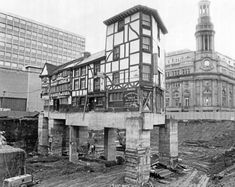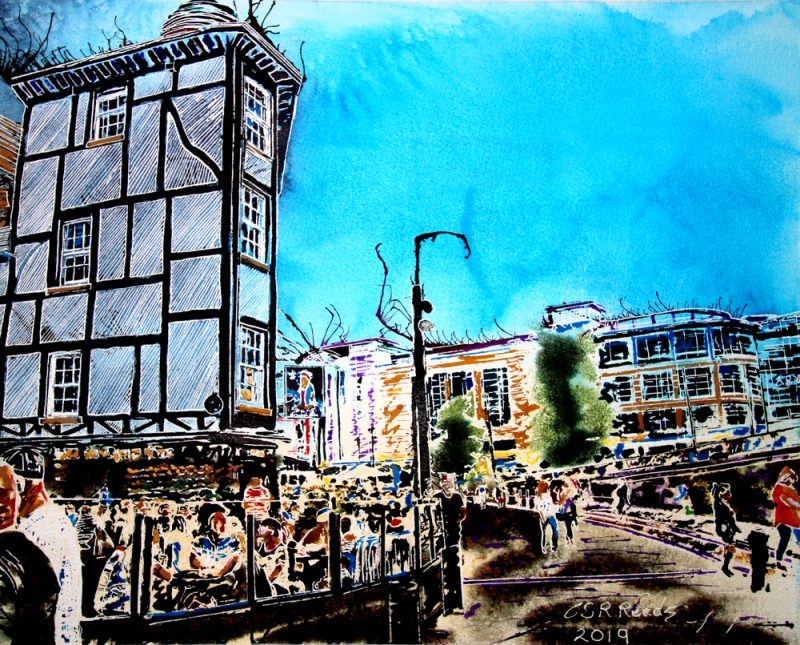Sinclair’s Oyster Bar, in Shambles Square, is one of the only surviving Tudor buildings in Manchester centre. A wonderful part of the city scene, oozing with interesting, rich history. Charming beyond words!
Cathy Read captures The Shambles for the unexpected pleasure it is, in a modern city. A relic of the past rescued from the wrecking ball just in the nick of time. Architect and civil engineer duo – Ian Simpson and Martin Stockley – hatched a radical plan to relocate two medieval city pubs, piece by piece to save them.
Shambles Rescue
In 1974, Sinclair’s Oyster Bar and the Old Wellington were jacked up, turned 180 degrees, and moved 300 metres northwards to their present location in Shambles Square – the term “shambles” comes from the street name where butchers would slaughter and sell meat. Today, Sinclair’s Oyster Bar is tucked away nicely behind Manchester cathedral occupying one of the oldest buildings in Shambles Square.

Cathy Read’s painting captures the building’s distinctive Tudor style, towering triumphantly above the scene. Clearly defined black and white beams and plastered walls make a characteristic medieval statement, “We’re still here!”. Distinct lines contrast with the chaos of colour and line in the rest of the painting. The distant buildings have a strong linear construction with tentative scribbles of colour, so they stand out prominently rather than fade into the pale wash.
Festive Café
The packed oyster bar pavement café is festive. Customers enjoy the afternoon sunshine chatting over beers and meals. Amblers comfortably wander the street in pairs. Two men in T-shirts vanish to the left. Lost in conversation, a pair of girls walk towards us. A young girl in a black uniform follows her mother like a duckling. A couple in shorts stroll away in the distance. Follow the glass barrier’s line until your eye rests on a solitary figure in black at the opening, checking-in a steady stream of customers.
Colour is focused on the lower half of the painting mainly accenting the people. A splash brightens the shop sign at the bottom and flickers on the bar’s right window. A yellow streak hints at a tram on the road in front of the distant buildings. Do you spot a brolly providing shade for dining customers? In the distance two trees offer the only greenery in the terrain engineered by man.
Permanent Tudor England
Back to the Shambles then. The walls, like blocks stacked upon one another, piece together in a higgledy-piggledy manner. Windows, that have witnessed many changes, peep out over a fresh scene. We could venture a guess at what original Mancunian owners and builders would think of the newfangled setting. They might be startled and firmly object, “We’re not mad fer it…” Too strange and alien, beyond their imagination, and probably shocking.
The Shambles has seen many centuries of humanity pass by, yet it stood the test of time essentially unaltered. Maybe some minor updates, modernizations, and tweaks, but it remains the familiar building of Tudor England. In chaotic and shambolic times, Cathy Read’s painting, The Shambles, leaves a restful sense of permanency in the grand scheme of things.

